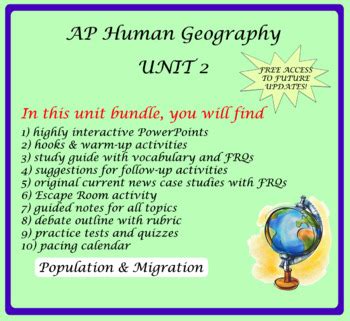Human Population Patterns
- Population distribution: Unevenly distributed across the globe, influenced by factors such as climate, natural resources, and economic development.
- Population density: Number of people per unit area, ranging from densely populated urban centers to sparsely populated rural areas.
- Population growth: Estimated to reach 10 billion by 2050, with variations in rates across countries and regions.
- Population structure: Age and sex composition, affecting factors such as healthcare needs, labor force participation, and economic growth.
Population Growth and Change
- Factors influencing population growth: Fertility rates, mortality rates, and migration.
- Demographic transition model: Explains the transition from high birth and death rates to low rates in developed countries.
- Population pyramids: Graphical representations of population structure and can provide insights into population trends.
- Population momentum: Continued population growth even after fertility rates decline due to the large number of young people.
Migration
- Types of migration: Internal (within a country) or international (between countries).
- Causes of migration: Economic opportunities, political instability, environmental disasters, and family reunification.
- Consequences of migration: Economic growth, cultural diversity, and social integration in receiving countries.
- Refugees and asylum seekers: Individuals fleeing persecution or conflict, requiring specialized assistance and protection.
Population Policies and Issues
- Population control: Measures taken by governments to influence population growth, such as family planning programs.
- Aging populations: Increasing proportion of elderly individuals due to declining fertility and increasing life expectancy.
- Urbanization: Movement of people to cities, leading to challenges in infrastructure, housing, and pollution.
- Sustainable development: Balancing population growth with environmental and economic sustainability.
Population Distribution and Density
- Case study: China’s one-child policy, which significantly reduced population growth.
- Concept: Geographic factors, such as access to water and fertile land, influence population density.
Population Growth and Change
- Case study: India’s rapid population growth and its impact on economic development and urbanization.
- Concept: Demographic transition models vary across countries and can be influenced by factors such as education and healthcare.
Migration
- Case study: Syrian refugee crisis and its impacts on receiving countries in Europe.
- Concept: Migration flows are driven by complex factors, including economic and political conditions.
Population Policies and Issues
- Case study: Thailand’s successful family planning program, which reduced fertility rates and stabilized population growth.
- Concept: Population policies can have both positive and negative consequences and require careful planning and implementation.
Urban Planning
- Essential: Understanding population distribution and growth patterns for efficient infrastructure and housing development.
- Example: Urban planners use data on population density to determine the optimal location for new transit lines and parks.
Economic Development
- Crucial: Analyzing population structure and growth for labor force planning and skill development.
- Example: Governments design educational programs tailored to meet the needs of a growing young population.
Health and Welfare
- Critical: Monitoring population health indicators and aging trends for healthcare resource allocation.
- Example: Public health officials use data on life expectancy and disease prevalence to develop targeted interventions.
Environmental Sustainability
- Vital: Understanding population growth and its impact on resource consumption and pollution.
- Example: Environmentalists advocate for policies that promote sustainable population growth and reduce carbon emissions.
The study of unit 2 AP human geography is essential for understanding the complex dynamics of human populations and their impact on societies and the environment. By analyzing population distribution, growth, migration, and policies, professionals and policymakers can address challenges and create sustainable solutions for the future.

